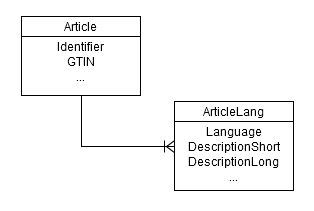REST Field Qualification
Product Manager defines many business objects which are described in the Product Manager repository. The repository can be seen as a storage for all meta-data regarding the business models. All objects and all attributes of those objects are described in there. Additionally to that, also the relation between an object and it's child objects is described in the repository. You can find a detailed description about the Repository here.
An example would be the object "Article" and it's child object "ArticleLang". An Article can have multiple "ArticleLang" records, one for each language. Therefore, the language is the attribute which makes the "ArticleLang" records unique for a single item.

To "fully qualify" a field means, that you not only must define which field (by the field's identifier), but also all values for all attributes which identify the children uniquely. In this example, just the language.
Syntax
Fully qualified field: <Field Identifier>[(<first logical key value>,..,<n-logical key value>)]
Multiple Field Qualification: <Fully qualified field>[, <Fully qualified field>]
|
Element |
Definition |
|
Field Identifier |
Basically the unique field identifier as given in the custom section of the repository. These identifiers typically but not necessarily start with the entity identifier separated by a "." from the filed's name. This makes the field unique in case of the same field supported by different data entities. Samples are:
|
|
Logical Key Value |
The qualification value for the first, second, third and so on logical key. Which logical key is on which position is defined by the hierarchy and the order attribute of the repository logical key type. In case no order attribute is defined in the repository, the order is defined by the relative location in the repository xml file. |
Logical Key Value Definition
The definition of the logical key value depends on the datatype of the logical key (or it's respective field) and whether the logical key has an enumeration or not.
With Enumeration
You can define everything which can be interpreted by the enumeration as a synonym to one of it's keys. This can be done either as a constant value, or as a string (constants are not allowed to have spaces in it, use strings in this case!)
For example: ArticleLang.DescriptionShort(en), ArticleLang.DescriptionShort(eng), ArticleLang.DescriptionShort(English) would be just the same.
Furthermore the key of an enumeration can be used if it's data type is not an entity item, like buyers, suppliers, units etc.
For example: ArticleLang.DescriptionShort(9)
A special situation would be a logical key which has an enumeration and it's data type is entity item. In this case you can either specify the actual entity item with the entity item syntax, as well as
a string or constant which is then parsed with the enumerations synonyms.
Some enumerations are case sensitive regarding their synonyms. Which one those are is defined in the enumeration itself. You're always on the safe side if you treat all of them as case-sensitive.
Without Enumeration
Logical keys without enumeration must be defined depending on their datatype. Please see the REST Datatypes overview for details.
|
Datatype |
Format |
Example |
|
Date (without time!) |
YYYY-MM-DD |
2012-06-22 which is the 22nd of June in 2012 |
|
Time (without date!) |
HH:mm:SS |
13:15:05 which is quarter past one, pm and five seconds |
|
Date and Time |
YYYY-MM-DD HH:mm:SS |
2012-06-22 13:15:05 |
|
Integer |
+#* or -#* |
+1247 or -1247 |
|
Decimal |
+#*.#* or -#*.#* |
+1.45 or -1.45 (no thousand seperator, use dot as comma seperator!) |
|
Boolean |
true or false |
true or false |
|
String |
"any string" or "any \"important\" string" |
"My Attribute Name" escape the quotation marks by a backslash! E.g. "Size in \"" (meaning: size in inch) |
|
Constant |
any string a-Z followed by zero or more 0-9 |
eng, de, public |
|
ENTITY_ITEM |
Entity Item without a container item: '<external_identifier>'|<internal_id> Entity Item with a container item: '<external_identifier>'|<internal_id>@'<container_external_identifier>'|<container_internal_id> Please don't forget use single quotes when you want |
'SomeItem'@'SupplierCat1' 12345@5 'SomeSupplier' 42 |
|
Dynamic Value |
A dynamic value is a placeholder which will be resolved while parsing the field qualification Note: additional named values can be contributed to the PIM server |
Currently available named values:
|
Examples
The short description of an article in english: ArticleLang.DescriptionShort(eng)
The public customer price value, in Euro for Germany, Valid on the 06/22/2012, when I order one: ArticlePriceValueSales.Amount(public,net_customer,eur,de,2012-06-22,1.00)
Using default values
If the repository defines a default value for the logical key then the default value can be referenced in the field qualification using the following notation:
${Default}
Note that the resulting fully qualified field may change when the definitions in the repository change.
Using wildcard matching
If no value can be defined as qualification, it is possible to use the
${Empty}qualifier.